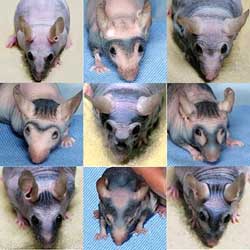| RIKEN Center for Developmental Biology
(CDB) 2-2-3 Minatojima minamimachi, Chuo-ku, Kobe 650-0047, Japan |
August 20, 2003 — A well-characterized reaction that produces wave-like patterns in chemical media provides an apt mathematical description for a pattern-forming phenomenon in the skin of a mutant mouse, report researchers at the RIKEN Center for Developmental Biology (CDB) in Kobe, Japan. These mice, which have defects in a gene responsible for hair follicle development, develop bands of darkened skin that oscillate and traverse the body surface in waves. In a paper published in the August 19 issue of the Proceedings of the National Academy of Sciences, Shigeru Kondo, in collaboration with researchers from the Medical School of Mie University, showed that these traveling waves of skin coloration are strikingly similar to nonlinear waves produced by the Belousov-Zhabotinskii (BZ) reaction in chemical systems, suggesting a shared underlying principle.
The question of how complex patterns arise from seemingly disorganized or formless initial structures represents an intriguing challenge to mathematicians, physicists, chemists and biologists alike. Theoretical work indicates that the mechanisms underlying pattern formation are similar in both biological and non-biological systems, and a number of mathematical models capable of describing pattern generation in chemical media have been proposed, but the greater complexity of living systems has made it much more difficult to demonstrate a mathematical basis for biological patterns In 1952, Alan Turing proposed the reaction-diffusion model, which explained how patterns could self-organize in systems in which two chemical substances interact with each other and diffuse at different rates. This paper laid the groundwork for subsequent investigations into the mathematical underpinnings of living patterns. The research described in the PNAS article
began when Kondo, whose research focuses on identifying the bases of biological pattern formation, was
told about a mutant strain of mouse with an unusual striped phenotype. The mutation, a splicing defect
in the Foxn1 (Whn or nude) gene, results causes hair follicle development to terminate just after skin
pigments begin to accumulate. The immature follicles die off and are quickly replaced by a new hair cycle.
The cyclical nature of this follicular attrition and re-activation by neighboring follicles produces a
phenotype in which the mouse’s skin color at first uniformly oscillates between dark and light coloration,
then begins to take on a remarkable striped appearance, with bands of pigmentation that originate from
region under the forearms and travel across the body surface in all directions. These waves first appear
at about three months after birth, and continue to arise and propagate throughout the life of the animal.
|
|||||
|
|||||
[ Contact ] Douglas Sipp : sipp@cdb.riken.jp TEL : +81-78-306-3043 RIKEN CDB, Office for Science Communications and International Affairs |
| Copyright (C) CENTER FOR DEVELOPMENTAL BIOLOGY All rights reserved. |
